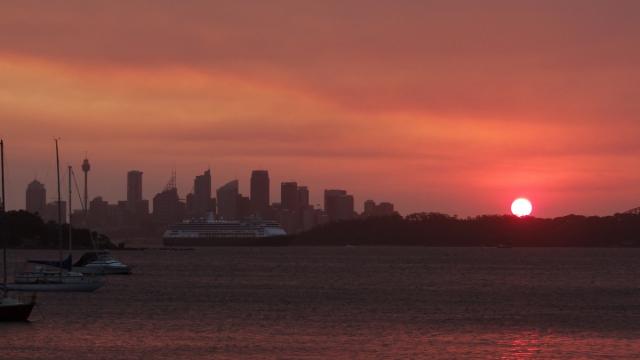The bushfires have been ravaging much of Australia’s east coast for weeks and while Sydney has been mostly spared, its air quality has not.
[referenced url=”https://gizmodo.com.au/2019/11/as-australia-burns-the-government-is-giving-10m-in-drought-relief-to-private-schools-only/” thumb=”https://gizmodo.com.au/wp-content/uploads/2019/11/nigel-410×231.jpg” title=”As Australia Burns, The Government Is Giving $10M In Drought Relief To Private Schools Only” excerpt=”Earlier this month the Australian government revealed a $1.5 billion drought relief fund. Some of this money will be used to to expand the previously-existing drought communities program, as well as set up a discretionary fund to support areas in need as needed. $10 million is also being set aside for drought relief for schools in impacted areas. This would be great if it wasn’t only being given to private schools.”]
There have already been a number of days that the NSW capital has been shrouded in bushfire smoke but the air quality index (AQI) rating, provided by the NSW Department of Planning, Industry and Environment, for November 22 marks the worst in the city’s recorded history.
“The impacts of the ongoing drought and recent bushfires have led to some of the highest levels of air pollutants recorded in NSW since air quality monitoring began during the millennium drought,” a department spokesperson confirmed to Gizmodo Australia.
“Smoke from the current bushfire emergency is having widespread impacts across northern NSW, the North Coast, Northern Tablelands and into the Hunter and Sydney regions. Air quality is expected to be poor in areas in close proximity to the bushfires.”
For air quality pollution levels to be deemed ‘hazardous’ ” the most severe category ” they need to hit 200 or more. The AQI index ratings show Richmond, the city’s far north-west region is experiencing a rating of 640, Macquarie Park, a suburb in northern Sydney, reached 239 while Bargo in the south-west toward Wollongong, experienced levels at 319. All those ratings marked the highest in the region on record.
Because of all these ratings, Sydney has an overall AQI rating of ‘poor’ while parts of NSW, including the Central Coast have a ‘very poor’ rating ” the category before the ominous-sounding ‘hazardous’.
“Everyone, especially people with heart or lung disease, should avoid outdoor exertion and stay inside as much as possible,” the department’s warning read for regions experiencing hazardous levels.
Going over the Harbour Bridge. Sydney blanketed in bushfire smoke again. Are we allowed to talk about climate change yet? pic.twitter.com/DQpTZED96n
— Shane Bazzi (@shanebazzi) November 20, 2019
The department explains “pollutants arise from natural processes like bushfires and from human activities, such as industrial and transport processes. Some, called ‘secondary pollutants’, form in the air when directly emitted (or primary) pollutants react with other substances or each other.”
The specific pollutant causing Sydney and NSW’s smoky skies in this instance is particulate matter (PM) and they’re split into two categories. Acccording to the NSW Department of Health, PM10, particles measuring 10 micrometres or less in diameter, are small enough to enter through the nose and mouth and enter the lungs. There are also PM2.5, 2.5 micrometres or less in diameter, can also enter the lungs during cavities but it’s small enough to enter your bloodstream.
Smoke from #bushfires continues to affect large parts of NSW. People with existing lung and heart conditions like asthma, emphysema and angina should avoid outdoor activity and follow your disease management plan. #NSWFires pic.twitter.com/Tso8UCPNei
— NSW Health (@NSWHealth) November 20, 2019
The Health Department outlines the following symptoms can occur from short or long-term exposure to the pollution:
Short-term exposure (hours to days):
- Irritated eyes, nose and throat
- Worsening asthma and lung diseases such as chronic bronchitis (also called chronic obstructive pulmonary disease or COPD)
- Heart attacks and arrhythmias (irregular heart beat) in people with heart disease
- Increases in hospital admissions and premature death due to diseases of the respiratory and cardiovascular systems
Long-term exposure (many years):
- Reduced lung function
- Development of cardiovascular and respiratory diseases
- Increased rate of disease progression
- Reduction in life expectancy
In order to keep yourself safe during days with poor air pollution, the NSW Health Department recommends avoiding physical exercise or any vigorous activity as well as staying indoors where possible.
[referenced url=”https://gizmodo.com.au/2019/11/how-does-poor-air-quality-from-bushfire-smoke-affect-our-health/” thumb=”https://gizmodo.com.au/wp-content/uploads/2015/07/bushfire-edited-410×231.jpg” title=”How Does Poor Air Quality From Bushfire Smoke Affect Our Health?” excerpt=”New South Wales and Queensland are in the grip of a devastating bushfire emergency, which has tragically resulted in the loss of homes and lives.”]
